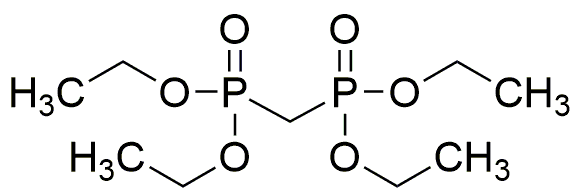Tetraethyl methylenediphosphonate is widely utilized in research focused on:
- Agricultural Chemistry: This compound serves as a key ingredient in developing herbicides and pesticides, enhancing crop protection against pests and diseases.
- Pharmaceuticals: It is used in drug formulation, particularly in creating phosphonate derivatives that exhibit antiviral and anticancer properties, providing innovative solutions in medicine.
- Material Science: Tetraethyl methylenediphosphonate acts as a coupling agent in the synthesis of advanced materials, improving the durability and performance of polymers and composites.
- Environmental Science: This chemical plays a role in the remediation of contaminated sites, particularly in the removal of heavy metals from soil and water, contributing to environmental sustainability.
- Analytical Chemistry: It is utilized in various analytical techniques, including NMR and mass spectrometry, aiding researchers in characterizing complex chemical structures effectively.
General Information
Properties
Safety and Regulations
Applications
Tetraethyl methylenediphosphonate is widely utilized in research focused on:
- Agricultural Chemistry: This compound serves as a key ingredient in developing herbicides and pesticides, enhancing crop protection against pests and diseases.
- Pharmaceuticals: It is used in drug formulation, particularly in creating phosphonate derivatives that exhibit antiviral and anticancer properties, providing innovative solutions in medicine.
- Material Science: Tetraethyl methylenediphosphonate acts as a coupling agent in the synthesis of advanced materials, improving the durability and performance of polymers and composites.
- Environmental Science: This chemical plays a role in the remediation of contaminated sites, particularly in the removal of heavy metals from soil and water, contributing to environmental sustainability.
- Analytical Chemistry: It is utilized in various analytical techniques, including NMR and mass spectrometry, aiding researchers in characterizing complex chemical structures effectively.
Documents
Safety Data Sheets (SDS)
The SDS provides comprehensive safety information on handling, storage, and disposal of the product.
Product Specification (PS)
The PS provides a comprehensive breakdown of the product’s properties, including chemical composition, physical state, purity, and storage requirements. It also details acceptable quality ranges and the product's intended applications.
Certificates of Analysis (COA)
Search for Certificates of Analysis (COA) by entering the products Lot Number. Lot and Batch Numbers can be found on a product’s label following the words ‘Lot’ or ‘Batch’.
*Catalog Number
*Lot Number
Certificates Of Origin (COO)
This COO confirms the country where the product was manufactured, and also details the materials and components used in it and whether it is derived from natural, synthetic, or other specific sources. This certificate may be required for customs, trade, and regulatory compliance.
*Catalog Number
*Lot Number
Safety Data Sheets (SDS)
The SDS provides comprehensive safety information on handling, storage, and disposal of the product.
DownloadProduct Specification (PS)
The PS provides a comprehensive breakdown of the product’s properties, including chemical composition, physical state, purity, and storage requirements. It also details acceptable quality ranges and the product's intended applications.
DownloadCertificates of Analysis (COA)
Search for Certificates of Analysis (COA) by entering the products Lot Number. Lot and Batch Numbers can be found on a product’s label following the words ‘Lot’ or ‘Batch’.
*Catalog Number
*Lot Number
Certificates Of Origin (COO)
This COO confirms the country where the product was manufactured, and also details the materials and components used in it and whether it is derived from natural, synthetic, or other specific sources. This certificate may be required for customs, trade, and regulatory compliance.

